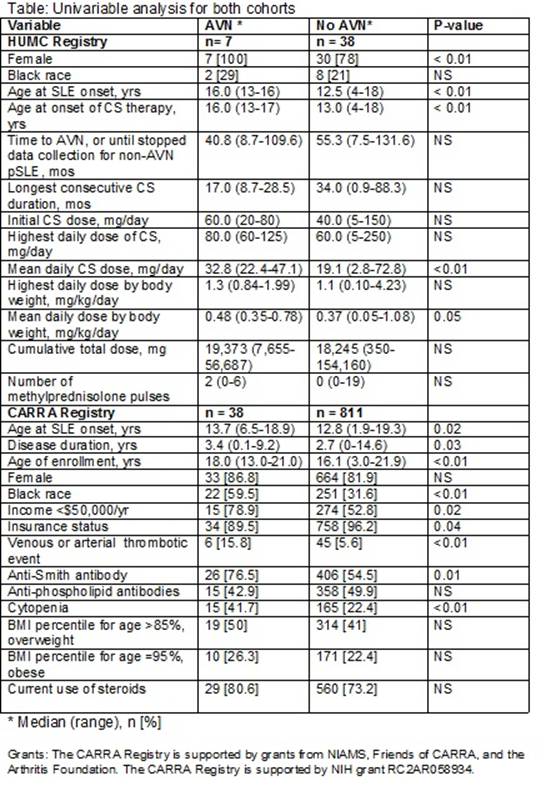Session Information
Session Type: Abstract Submissions (ACR)
Background/Purpose: Avascular necrosis (AVN) is a serious morbidity of pediatric systemic lupus erythematosus (pSLE) associated with disability, impaired quality of life, and increased cost of care. Both SLE and corticosteroid (CS) treatment have been associated with AVN but understanding of pathogenesis remains limited, and few pSLE studies have been conducted.
Methods: We conducted retrospective reviews of two pSLE cohorts, a single center site (HUMC) and from the CARRA Registry. Data from the HUMC cohort (pSLE patients seen at HUMC between 2006-2009) included disease course and manifestations, morbidity, CS treatment details, and laboratory test results at selected times. Data on HUMC pSLE AVN patients was collected from initial clinic visit until diagnosis of AVN, and on HUMC non-AVN patients from initial visit through 2009. The CARRA Registry is a prospective registry of patients with pediatric rheumatic diseases in the US that includes demographic data, disease duration and manifestations, morbidity, and some laboratory studies. Only limited disease treatment data is available from this registry. We analyzed data on the CARRA pSLE patients from 5/2010-5/2013. For the HUMC data, non-parametric two-tailed p values were calculated. For the CARRA data, t-test and Chi-square tests were performed.
Results: There were 62 pSLE subjects in HUMC cohort, of whom 7 (11.3%) had AVN. Sufficient data were available for 38 of the non-AVN subjects to use as case controls. HUMC AVN patients had an older age at onset of SLE and CS treatment, and a higher mean daily CS dose than non-AVN. The median initial and highest daily CS dose were higher for HUMC AVN than non-AVN patients, but these did not achieve statistical significance (Table). There were 849 pSLE subjects in the CARRA Registry, and AVN was reported in 38 (4.5%). Factors associated with AVN are shown in Table.
Conclusion: AVN is an uncommon but potentially devastating complication. In both cohorts, older age at SLE onset was associated with occurrence of AVN. In the CARRA Registry, longer disease duration, Black race, and presence of Smith antibodies were also associated. In the HUMC cohort, a higher mean daily CS dose was associated with AVN, while total cumulative dose, duration of treatment, and highest dose were not. Prospective studies are needed to better assess these potential risk factors and work towards improving our understanding of AVN pathogenesis.
Disclosure:
R. Gurion,
None;
H. Yang,
None;
H. Li,
None;
S. Frenkian,
None;
K. A. Haines,
None;
J. E. Weiss,
None;
Y. Kimura,
None;
A. S. Zeft,
Pfizer Inc,
1;
A. B. Robinson,
None;
S. C. Li,
None;
F. T. CARRA Registry Investigators,
None.
« Back to 2013 ACR/ARHP Annual Meeting
ACR Meeting Abstracts - https://acrabstracts.org/abstract/risk-factors-for-the-development-of-avascular-necrosis-in-pediatric-systemic-lupus-erythematosus-patients/

